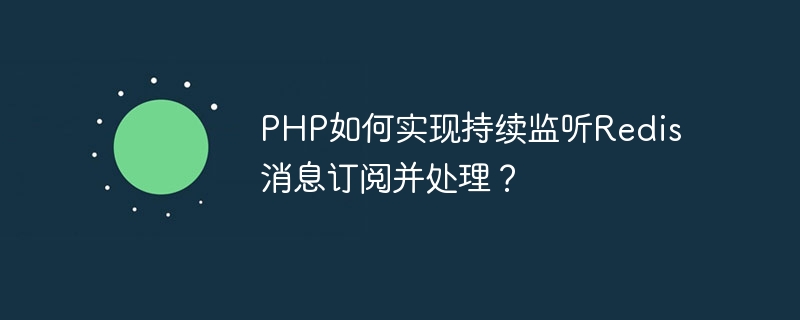Home >Backend Development >PHP Tutorial >How does PHP continuously listen to Redis message subscriptions and process them?
How does PHP continuously listen to Redis message subscriptions and process them?
- WBOYWBOYWBOYWBOYWBOYWBOYWBOYWBOYWBOYWBOYWBOYWBOYWBOriginal
- 2023-09-05 17:12:25793browse

How does PHP implement continuous monitoring and processing of Redis message subscriptions?
Redis is an open source in-memory database that is widely used in cache, queue, message subscription and other scenarios. In actual development, we often need to implement continuous monitoring and processing of Redis messages. This article will introduce how to use PHP to subscribe to and process Redis messages, and provide code examples.
First of all, we need to ensure that the Redis extension has been installed. You can install the Redis extension through the following command:
$ pecl install redis
After the installation is complete, introduce the Redis extension into the PHP code:
<?php
// 引入Redis扩展
extension_loaded('redis') || dl('redis.so');
?>The following is a simple example that demonstrates how to subscribe to and process Redis messages:
<?php
// 连接Redis服务器
$redis = new Redis();
$redis->connect('127.0.0.1', 6379);
// 订阅频道
$redis->subscribe(['channel'], function ($redis, $channel, $message) {
// 处理消息
echo "收到来自频道 {$channel} 的消息:{$message}
";
// 当收到"quit"消息时结束订阅
if ($message == 'quit') {
$redis->unsubscribe();
}
});
// 关闭连接
$redis->close();
?>In the above example, we first connect to the Redis server through the connect method. Next, subscribe to one or more channels through the subscribe method. In the callback function, we can handle the received message. When a specific message (such as "quit") is received, call the unsubscribe method to end the subscription. Finally, use the close method to close the connection to the Redis server.
If we need to subscribe to multiple channels, we can pass in a channel array in the subscribe method:
$redis->subscribe(['channel1', 'channel2'], function ($redis, $channel, $message) {
// 处理消息
});It should be noted that Redis uses publish/subscribe mode, not queue mode. When we publish a message, all clients subscribed to the channel will receive the message. Unsubscribed clients will not be able to receive previously published messages.
In addition to using callback functions to process messages, we can also achieve parallel processing by creating a child process. Here is an example:
<?php
// 创建子进程
$pid = pcntl_fork();
if ($pid == -1) {
// 创建失败
die('Fork failed');
} elseif ($pid == 0) {
// 子进程
$redis = new Redis();
$redis->connect('127.0.0.1', 6379);
$redis->subscribe(['channel'], function ($redis, $channel, $message) {
// 处理消息
echo "子进程收到来自频道 {$channel} 的消息:{$message}
";
// 当收到"quit"消息时结束订阅
if ($message == 'quit') {
$redis->unsubscribe();
}
});
$redis->close();
} else {
// 父进程
pcntl_waitpid($pid, $status);
}
?>In the above example, we created a child process through the pcntl_fork function. The code in the child process is the same as the previous example. The parent process waits for the child process to end through pcntl_waitpid.
Through the above code examples, we can realize PHP's continuous monitoring and processing of Redis messages. This mechanism is very suitable for scenarios such as message queues and real-time data processing. At the same time, we can also expand and optimize according to actual needs. I hope this article will help you understand and use PHP to implement Redis message subscription and processing.
The above is the detailed content of How does PHP continuously listen to Redis message subscriptions and process them?. For more information, please follow other related articles on the PHP Chinese website!

